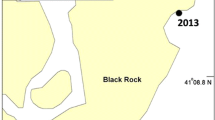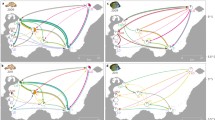Abstract
In benthic invertebrates dispersal of planktotrophic larvae is generally considered more effective than is, for example, the rafting of adults or egg masses. It is certainly true that over short distances, viz., in the range of tens of kilometres or less, a moderately long-lived planktotrophic larva represents an effective mechanism of dispersal. However, turbulent mixing and mortality will decrease the concentration of planktotrophic larvae, and at some distance from the ancestral population the density of settlers may be too low to enable future matings between adults of low mobility. On the other hand, adults, juveniles or benthic egg masses drifted over long distances may colonize new habitats. The crucial point is the type of larval development of the organism. If the founder group belongs to a species with direct development or which produces very short-lived planktonic larvae, the low mobility of all life-stages will maintain a population within a restricted area so that mates will be likely to encounter each other even in a small population. Even if transport of benthic stages happens very rarely, this may be more influential than larval dispersal over long distances. To show that this may be true the detailed geographical distribution of two intertidal gastropod species with contrasting modes of development is presented and further support from the literature for this hypothesis is discussed.
Similar content being viewed by others
Literature cited
Abbott, R. T. (1972). American seashells. Van Nostrand Reinhold, New York
Allen, J. A., Sheltema, R. S. (1972). The functional morphology and geographical distribution of Planktomya henseni, a supposed neotenus pelagic bivalve. J. mar. biol. Ass. U.K. 52: 19–31
Arnaud, F., Arnaud, P. M., Intés, A., Le Loeuff, P. (1976). Transport d'invertebres benthique entre l'Afrique du Sud et Sainte Hélene par les laminaires (Phaeophyceae). Bull. Mus. Nat. d'hist. Nat. 384: 49–55
Barsotti, G., Campani, E. (1982). Il promontorio di Castiglioncello (LI): III. Rinvenimento di una populazione di Littorina littorea (L.) — Moll. Gastropoda Prosobranchia. Quaderni Mus. St. Nat. Livorno 3: 65–71
Bequaert, J. C. (1943). The genus Littorina in the western Atlantic. Johnsonia 7: 1–28
Bird, J. B. (1968). Littorina littorea: Occurrence in a northern Newfoundland beach terrace, predating Norse settlements. Science, N.Y. 159: 114
Birkeland, C. (1971). Biological observations on Cobb Seamount. North West Science, N.Y. 45: 193–199
Boden, B. P. (1952). Natural conservation of insular plankton. Nature, Lond. 169: 697–699
Burton, R. S. (1983). Protein polymorphisms and genetic differentiation of marine invertebrate populations. Mar. Biol. Lett. 4: 193–206
Carefoot, T. (1977). Pacific seashores. Douglas & McIntyre, Vancouver
Carlquist, S. (1974). Island biology. Columbia University Press, New York
Carlton, J. T. (1982). The historical biogeography of Littorina littorea on the Atlantic coast of North America, and implications for the interpretation of the structure of New England intertidal communities. Malacol. Rev. 15: 146
Carlton, J. T. (1985). Transoceanic and interoceanic dispersal of coastal marine organisms: The biology of ballast water. Oceanogr. mar. Biol. A. Rev. 23: 313–371
Chapman, A. R. O. (1986). Population and community ecology of seaweeds. In: Blaxter, J. H. S., Southward, A. J. (es.) Advances in marine biology. Vol. 23. Academic, London, p. 1–161
Chia, F.-S. (1974). Classification and adaptive significance of developmental patterns in marine invertebrates. Thal. Jugosl. 10: 121–130
Christiansen, F. B., Fenchel, T. (1979). Evolution of marine invertebrate reproductive patterns. Theor. Pop. Biol. 16: 267–282
Clarke, A. H., Erskine, J. S. (1961). Pre-Columbian Littorina littorea in Nova Scotia. Science, N.Y. 134: 393–394
Cohen, D. (1967). Optimization of seasonal migratory behavior. Am. Nat. 101: 5–17
Crisp, D. J. (1958). The spread of Elminus modestus in North West Europe. J. mar. biol. Ass. U.K. 37: 483–520
Crisp, D. J. (1974). Energy relations of marine invertebrate larvae. Thalassia Jugoslavica 10: 103–120
Crisp, D. J. (1978). Genetic consequences of different reproductive strategies in marine invertebrates. In: Battaglia, B., Beardmore, J. A. (eds.) Marine organisms: genetics, ecology and evolution. Plenum, New York, 257–273
Crisp, D. J., Southward, A. J. (1958). The distribution of intertidal organisms along the coasts of the English Channel. J. mar. biol. Ass. U.K. 37: 147–208
Dautzenberg, P. (1893). Description d'une nouvelle espèce du genre Littorina, provenant des côtes de la Tunisie. J. de Conchyliologie 41: 35–36
Davis, D. S. (1971). Variation in the northern rough periwinkle, Littorina saxatilis (Olivi) in Nova Scotia. Proc. N. S. Inst. Sci. 27: 61–90
Emery, A. R. (1972). Eddy formation from an oceanic island: ecological effects. Carib. J. Sci. 12: 121–128
Fretter, V., Graham, A. (1980). The prosobranch molluscs of Britain and Denmark. Part 5. Marine Littorinacea. J. moll. Stud. Suppl. 7
Fretter, V., Shale, D. (1973). Seasonal changes in population density and vertical distribution of prosobranch veligers in offshore plankton at Plymouth. J. mar. biol. Ass. U.K. 53: 471–492
Gadgil, M. (1971). Dispersal: population consequences and evolution. Ecology 52: 253–261
Gerlach, S. A. (1977). Means of meiofauna dispersal. Mikrofauna Meeresboden 61: 89–103
Gofas, S. (1975). Sur l'extension de Littorina saxatilis (Olivi) (Moll. Gaster.) dans le detroit de Gibraltar. Bull. Soc. Sci. Nat. et Phys. du Marco 55: 95–99
Hadfield, M. G. (1978). Growth and metamorphosis of planktonic larvae of Ptychodera flava (Hemichordata: Enteropneusta). In: Chia, F.-S., Rice, M. E. (1978). Settlement, and metamorphosis of marine invertebrate larvae. Elsevier, New York, p. 247–254
Hawkins, S. J., Hiscock, K. (1983). Anomalies in the abundance of common eulittoral gastropods with planktonic larvae on Lundy Island, Bristol Channel. J. moll. Stud. 49: 86–88
Hedgecock, D. (1986). Is gene flow from pelagic larval dispersal important in the adaptation and evolution of marine invertebrates? Bull. mar. Sci. 39: 550–564
Highsmith, R. C. (1885). Floating and algal rafting as potential dispersal mechanisms in brooding invertebrates. Mar. Ecol. Prog. Ser. 25: 169–179
Hines, A. H. (1986). Larval patterns in the life of brachyuran crabs (Crustacea, Decapoda, Brachyura). Bull. mar. Sci. 39: 444–466
Hines, A. H. (1986b). Larval problems and perspectives in life histories of marine invertebrates. Bull. mar. Sci. 39: 506–525
Hughes, R. N. (1979). South African populations of Littorina rudis. Zool. J. Linn. Soc. 65: 119–126
Jablonski, D. (1986). Larval ecology and macroevolution in marine invertebrates. Bull. mar. Sci. 39: 565–587
Jablonski, D. (1987). Heritability at the species level: analysis of geographic ranges of Cretaceous mollusks. Science, N.Y. 238: 360–363
Jablonski, D., Flessa, K. W., Valentine, J. W. (1985). Biogeography and paleobiology. Paleobiology 11: 75–90
Jablonski, D., Lutz, R. A. (1983). Larval ecology of marine benthic invertebrates: paleobiological implications. Biol. Rev. 58: 21–89
Jackson, J. B. C. (1986). Modes of dispersal of clonal benthic invertebrates: consequences for species' distributions and genetic structure of local populations. Bull. mar. Sci. 39: 588–606
Janson, K. (1985). A morphologic and genetic analysis of Littorina saxatilis (Prosobranchia) from Venice, and on the problem of saxatilis-rudis nomenclature. Biol. J. Linn. Soc. 24: 51–59
Janson, K. (1987). Genetic drift in small and recently founded populations of the marine snail Littorina saxatilis. Heredity 58: 31–37
Kempf, S. C. (1981). Long-lived larvae of the gastropod Aplysia juliana: do they disperse or just slowly fade away? Mar. Ecol. Prog. Ser. 6: 61–65
Kilburn, R. N. (1972). Taxonomic notes on South African marine mollusca (2), with the description of new species and subspecies of Conus, Nassarius, Vexillum and Demoulia. Ann. Natal. Mus. (Pietermaritzburg) 21: 391–437
Knight, A. J., Hughes, R. N., Ward, R. D. (1987). A striking example of the founder effect in the mollusc Littorina saxatilis. Biol. J. Linn. Soc. 32: 417–426
Knudsen, J. (1950). Egg capsules and development of some marine prosobranchs from tropical West Africa. Atlantide Report 1: 85–130
Lobel, P. S., Robinson, A. R. (1986). Transport and entrapment of fish larvae by ocean mesoscale eddies and currents in Hawaiian waters. Deep-Sea Res. (A), 33: 483–500
Malone, C. R. (1965). Killdeer (Charadrius vociferus Linnaeus) as a means of dispersal for aquatic gastropods. Ecology 46: 551–552
McDowall, R. M. (1968). Oceanic islands and endemism. Syst. Zool. 17: 346–350
Mileikovsky, S. A. (1971). Types of larval development in marine bottom invertebrates their distribution and ecological significance: a reevaluation. Mar. Biol. 10: 193–213
Moore, P. H. (1977). Additions to the littoral fauna of Rockall, with a description of Araeolaimus penelope sp.nov. (Nematoda: Axonolaimidae). J. mar. biol. Ass. U.K. 57: 191–200
Okubo, A. (1971). Oceanic diffusion diagrams. Deep-Sea Res. 18: 789–802
Palmer, A. R., Strathmann, R. R. (1981). Scale of dispersal in varying environments and its implications for life histories of marine invertebrates. Oecologia (Berl.) 48: 308–318
Rosewater, J. (1975). An annotated list of the marine mollusks of Ascension Island, South Atlantic. Ocean. Smithsonian Contrib. Zool. No. 189
Scheltema, R. S. (1971). Larval dispersal as a means of genetic exchange between geographically separated populations of shallow-water benthic marine gastropods. Biol. Bull. 140: 284–322
Scheltema, R. S. (1978). On the relationship between dispersal of pelagic veliger larvae and the evolution of marine prosobranch gastropods. In: Battaglia, B., Beardmore, J. A. (eds.) Marine organisms: genetics, ecology and evolution. Plenum, New York, p. 303–322
Scheltema, R. S. (1986a). On dispersal and planktonic larvae of benthic invertebrates: an eclectic overview and summary of problems. Bull. mar. Sci. 39: 290–322
Scheltema, R. S. (1986b). Long-distance dispersal by planktonic larvae of shoal-water benthic invertebrates among central Pacific islands. Bull. mar. Sci. 39: 241–256
Strathmann, R. R. (1974). The spread of sibling larvae of sedentary marine invertebrates. Amer. Nat. 108: 29–44
Strathmann, R. R. (1978). Length of pelagic period in echinoderms with feeding larvae from the northeast Pacific. J. exp. mar. Biol. Ecol. 34: 23–27
Strathmann, R. R. (1986). What controls the type of larval development? Summary statement for the evolution session. Bull. mar. Sci. 39: 616–622
Stroud, D. A., Knudsen, J. (1982). The demography and reproduction of Littorina rudis Maton, 1797 from Greenland. In: Fox, A. D., Stroud, D. A. (eds.) Report of the 1979 Greenland Whitefronted Goose Study Expedition to Equalungmiut Nunat, West Greenland. Aberystwyth, p. 257–267
Thorson, G. (1946). Reproduction and larval development of Danish marine bottom invertebrates. Medd. Komm. Danm. Fisk.-Og. Havunders. ser. Plankton 4: 1–523
Thorson, G. (1950). Reproductive and larval ecology of marine bottom invertebrates. Biol. Rev. 25: 1–45
Todd, C. D., Doyle, R. W. (1981). Reproductive strategies of marine benthic invertebrates: a settlement timing hypothesis. Mar. Ecol. Prog. Ser. 4: 75–83
Vance, R. R. (1973). On reproductive strategies in marine benthic invertebrates. Am. Nat. 107: 339–352
Author information
Authors and Affiliations
Additional information
Communicated by T. Fenchel, Helsingør
Rights and permissions
About this article
Cite this article
Johannesson, K. The paradox of Rockall: why is a brooding gastropod (Littorina saxatilis) more widespread than one having a planktonic larval dispersal stage (L. littorea)?. Mar. Biol. 99, 507–513 (1988). https://doi.org/10.1007/BF00392558
Accepted:
Issue Date:
DOI: https://doi.org/10.1007/BF00392558




